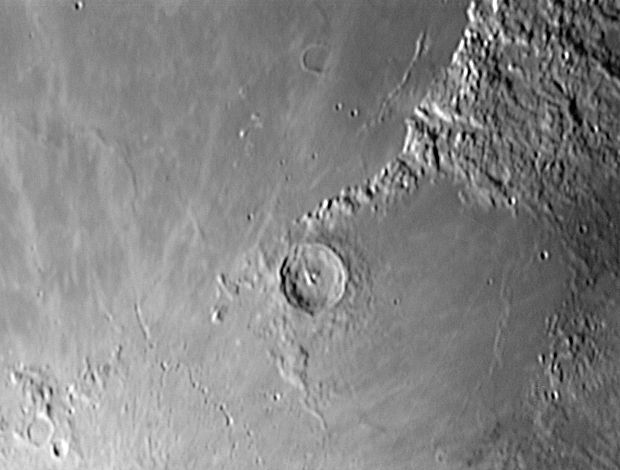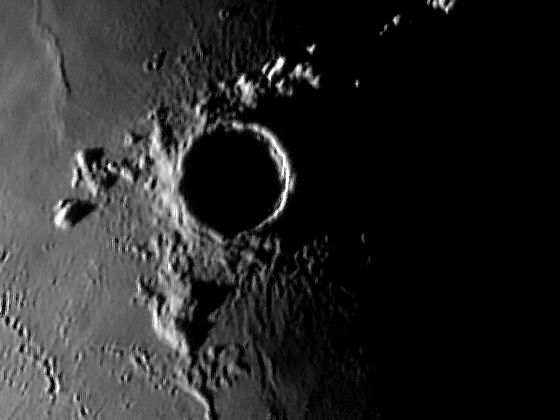

Move your mouse over the picture to see the names of some of the features.

Eratosthenes is 60 Km in diameter and a relatively young crater, at between 1,000 and 3,000 million years. It is some 3,600 metres deep and lies on the southern shores of the Mare Imbrium at the southern end of the Apennine mountains.
The picture was taken with a ToUcam attached to my LX200 on 12th December 2006 when the Moon was 21.7 days old.
Date and Time: 12 December 2006 04:08 UT
Camera: ToUcam 740K
Telescope: LX200
Capture: K3CCDTools. High gamma, 1/25", 26% gain, 509 frames
Processing: Registax. 5 alignment points, 391 frames stacked. Wavelet 1-2 = 10, contrast 140

This close-up view was taken at sunset on this part of the Moon. Eratosthenes itself is almost entirely in shadow, but the low angle of the Sun brings out the mountainous areas created, no doubt, by the material ejected by the impact that formed the crater. In particular are the two mountains to the south of Eritosthenes. As far as I can ascertain they have no names, but NASA's Lunar Astronomical Chart of this area indicates that the more-southerly peak has an elevation of 970 metres and the shadows in this picture seem to imply that the peak just to its north is higher.
A mosaic containing both Eratosthenes and Copernicus, taken the same night, can be seen here.
The picture was taken with a ToUcam attached to my LX200 with a X2 adaptor lens at 03:31 UT on 7th October 2004 when the Moon was 22.8 days old.
Date and Time: 7th October 2004 03:31 UT
Camera: ToUcam 740K
Telescope: LX200 with X2 lens
Capture: K3CCDTools. High gamma, 1/33", 32% gain, 437 frames
Processing: Registax. 110 frames stacked. Wavelet 1-3 = 10 Brightness -20

This close-up view was taken at sunset on this part of the Moon. Eratosthenes itself is almost entirely in shadow, but the low angle of the Sun brings out the mountainous areas created, no doubt, by the material ejected by the impact that formed the crater. In particular are the two mountains to the south of Eritosthenes. As far as I can ascertain they have no names, but NASA's Lunar Astronomical Chart of this area indicates that the more-southerly peak has an elevation of 970 metres and the shadows in this picture seem to imply that the peak just to its north is higher.
A mosaic containing both Eratosthenes and Copernicus, taken the same night, can be seen here.
The picture was taken with a ToUcam attached to my LX200 with a X2 adaptor lens at 03:31 UT on 7th October 2004 when the Moon was 22.8 days old.
Date and Time: 7th October 2004 03:31 UT
Camera: ToUcam 740K
Telescope: LX200 with X2 lens
Capture: K3CCDTools. High gamma, 1/33", 32% gain, 437 frames
Processing: Registax. 110 frames stacked. Wavelet 1-3 = 10 Brightness -20

This close-up view was taken at sunset on this part of the Moon. Eratosthenes itself is almost entirely in shadow, but the low angle of the Sun brings out the mountainous areas created, no doubt, by the material ejected by the impact that formed the crater. In particular are the two mountains to the south of Eritosthenes. As far as I can ascertain they have no names, but NASA's Lunar Astronomical Chart of this area indicates that the more-southerly peak has an elevation of 970 metres and the shadows in this picture seem to imply that the peak just to its north is higher.
A mosaic containing both Eratosthenes and Copernicus, taken the same night, can be seen here.
The picture was taken with a ToUcam attached to my LX200 with a X2 adaptor lens at 03:31 UT on 7th October 2004 when the Moon was 22.8 days old.
Date and Time: 7th October 2004 03:31 UT
Camera: ToUcam 740K
Telescope: LX200 with X2 lens
Capture: K3CCDTools. High gamma, 1/33", 32% gain, 437 frames
Processing: Registax. 110 frames stacked. Wavelet 1-3 = 10 Brightness -20 Home Back to NW Quadrant